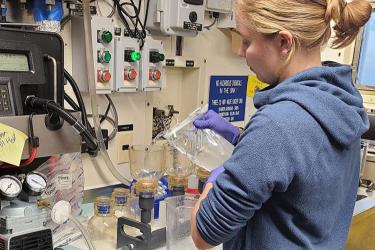
Southeastern Bering Sea sample stations (below 60 degrees north)
The NOAA Fisheries Strategic Climate Plan calls for predictive models of the consequences of climate change on ecosystems through monitoring changes in coastal and marine ecosystems, conducting research on climate-ecosystem linkages, and incorporating climate information into physical-biological models. The goal for this assessment is to develop models relating these fisheries-oceanographic indices to productivity of commercially important fish species (such as pollock, cod, herring, western Alaska salmon) in the southeastern Bering Sea.
The survey leverages Alaska Fisheries Science Center resources through partnerships in regional research programs such as North Pacific Research Board-funded projects, FATE, the North Pacific Anadromous Fish Commission's Bering Aleutian Salmon International Survey (BASIS), the Bering Sea Fisherman’s Association, the Alaska Sustainable Salmon Fund, and the Arctic Yukon Kuskokwim Sustainable Salmon Fund.
Data from these surveys have been used in the North Pacific Research Board, Bering Sea Ecosystem Integrated Research Program research activities, reports, and publications.
Additional Resources
- North Pacific Research Board
- Fisheries And The Environment
- Bering Sea Fisherman’s Association
- Arctic Yukon Kuskokwim Sustainable Salmon Fund
- Bering Arctic Subarctic Integrated Survey
- Alaska Sustainable Salmon Fund



